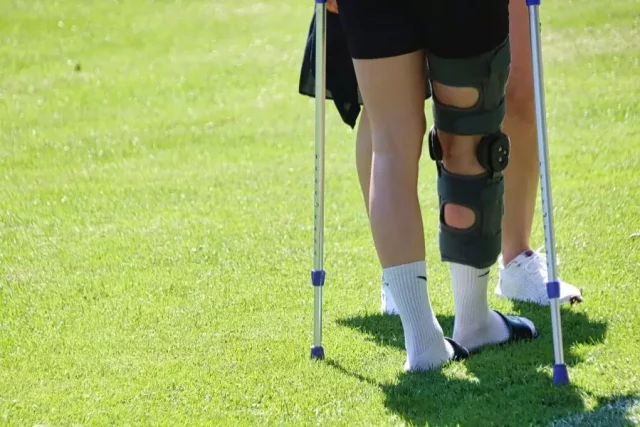If you suffer from bad knees, you know that it can be tough to live a normal life. Knees are essential for everyday activities like walking and climbing stairs, so if they are causing you pain, it can be challenging to do the things you enjoy. This blog post discusses tips for living an everyday life with bad knees. It will also provide information on how you can get relief from your knee pain. Keep reading for more details.
Wear The Proper Shoes
The shoes you wear can affect your knee pain. Flat feet or high arches can put additional stress on your knees. Shoes that provide good support and cushioning can help alleviate some of this stress. You may also want to consider using custom orthotics inserts if you have trouble finding comfortable shoes. These are designed to support your feet and can help reduce knee pain. For instance, an orthotic with arch support can help remove the pressure from your knees if you have flat feet. Support for high arches can also prevent knee pain because it helps distribute your weight more evenly.
If you’re unsure what type of shoe is best for you, ask a salesperson at a running or sporting goods store. They can help you find a shoe that fits well and provides the support you need. In this case, you need to consider both the size and width of the shoe. Choosing a shoe with a comfortable heel counter is also essential. The heel counter is the shoe part that surrounds your heel and provides support. A good heel counter will be firm, but not too stiff. You should also look for a rocker bottom. This sole helps reduce stress on the knees by rolling your foot forward as you walk.
Exercise
Even if you have bad knees, it is essential to stay active. Exercise helps strengthen the muscles around your joints, which can help take some of the pressure off your knees. Walking, swimming, and biking are all excellent exercises for people with knee problems, as these activities put minimal stress on the joints. If you are just starting to exercise, it’s essential to start slowly and gradually increase your activity level. For instance, you can do 10 minutes of walking on the first day and then add 5 minutes each day until you are up to 30 minutes. If you want to swim, start with a few laps and add more each time you go to the pool.
If you experience pain when exercising, listening to your body and taking a break when needed is essential. This means that you shouldn’t push yourself too hard. Exercise should not cause you pain, so if it does, stop and rest. You can also try icing your knees for 20 minutes after exercising to help reduce any inflammation or pain. Or, you may also want to consider working with a physical therapist to create an exercise program specifically designed for your needs. They may recommend low-impact but practical exercises such as water aerobics or Tai Chi.
It’s also crucial to stretch
Stretching is an integral part of keeping your joints healthy. You are lengthening the muscles and tendons around your joints when you stretch. This helps to keep them flexible and decreases your chances of injury. It’s a good idea to stretch both before and after you exercise. Static stretches, where you hold the stretch for 30 seconds or more, are the best if you have knee problems. Some good stretches for the knees include hamstring stretches, quadriceps stretches, and calf raises.
You can also try yoga
Yoga can be a great way to reduce knee pain. Many different yoga poses can help stretch and strengthen the muscles around your knees. Yoga can also help improve your flexibility, which can make it easier for you to do other activities that may be difficult with stiff joints. A few poses, in particular, can be beneficial for knee pain. These include the Camel pose, the Garland pose, and the Chair pose. It’s a good idea to take a class or two to learn how to do the poses correctly if you’re new to yoga.
Lose Weight
Losing weight can help with pain management for your knees if you are overweight. Every pound of weight you lose equals four pounds of pressure on your knees. So, if you lose just 10 pounds, that’s like taking 40 pounds of pressure off of your knees. Losing weight can also help reduce inflammation and pain in the joints. Talk to your doctor if you are struggling to lose weight. They can help you set realistic goals and support you to reach your goals.
For instance, if your BMI indicates that you are overweight, your doctor may recommend losing 5-10% of your body weight. They can also refer you to a registered dietitian who can help you make healthy food choices and create a calorie-controlled meal plan. In addition, they may also recommend that you increase your activity level. This could involve adding more exercise to your routine, or simply ensuring that you get up and move more throughout the day.
Get Regular Massages
Getting regular massages can help reduce knee pain by decreasing inflammation and improving blood flow to the area. Massage can also help to release any knots or tension in the muscles around the joint. If you can’t afford to go to a professional massage therapist, you can also try massaging your knees. Start by gently rubbing the muscles in a circular motion. You can also use a tennis ball or foam roller to massage the muscles around your knee joint. If you are experiencing knee pain, you must talk to your doctor. They can determine the cause of your pain and recommend the best treatment options. In some cases, knee pain can signify a more severe problem, such as arthritis or a ligament injury. Therefore, it is vital to get a proper diagnosis to get the treatment you need.
There are many different things that you can do to reduce knee pain and live everyday life. Be sure to talk to your doctor so that they can help you create a treatment plan that is right for you. With proper care, you can reduce your pain and live a whole, active life.














